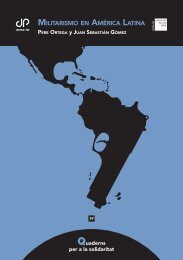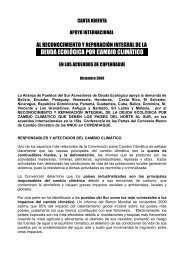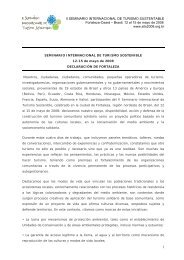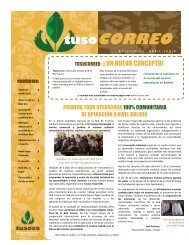Beyond Greening - Tourism Watch
Beyond Greening - Tourism Watch
Beyond Greening - Tourism Watch
Create successful ePaper yourself
Turn your PDF publications into a flip-book with our unique Google optimized e-Paper software.
<strong>Beyond</strong> <strong>Greening</strong>: Reflections on <strong>Tourism</strong> in the Rio-Process | PositioningpaperFar from a Green Economy:Environmental Neglect by Transnational CorporationsBy Joan BuadesWhile transnational corporations (TNCs) boast of their environmental commitments andawards, they neglect to take responsibility for three main issues in the global crisis that isaffecting the planet: climate change, the loss of biodiversity and water stress. As we know by itseffect on the world economy and its share of responsibility regarding climate change, theexploitation of common goods and the colonisation of the planet’s impoverishedcommunities, actions regarding international tourism will be decisive in the coming years.Climate ChangeNormally, emphasis tends to be placed on how the greenhouse effect might influence thefeasibility of the tourist trade in the various regions of the world. However, official calculationsregarding the extent to which tourism is contributing to climate deterioration are becomingincreasingly worrying. A recent report by the United Nations Environment Programme(UNEP) draws attention to the extent to which the sector’s influence on climate change isunderestimated. Moving beyond the usually quoted figure of five percent of responsibility, theUN states that if all greenhouse gases are considered rather than just CO 2 , tourism would beresponsible for as much as 14 percent of all emissions. What is more, the report admits thatthe calculation is a conservative one, as it does not include the energy cost of building hotels,airports, roads and motorways.Focusing on CO 2 generation, the five percent from tourism is heavily influenced by themassive repercussions transport has on this figure (up to 90 percent). Furthermore, the type oftransport matters: air travel accounts for 54 to 75 percent of emissions. Buses and trainsaccount for 34 percent of journeys made by tourists, but are responsible for only 13 percent ofthe emissions. However, although long-haul air travel accounts for barely 2.7 percent ofinternational tourism, it produces 17 percent of tourism-related CO 2 emissions. The UN addsthe revealing point that responsibility is highly unequal, as international tourism is a productthat is enjoyed each year by around 140 million people, barely two percent of the worldpopulation (Simpson et al, 2008, pp. 15-16 and 66-67).Medium-term forecasts are much worse: by around 2035, tourism will grow by 179 percentand its contribution to the greenhouse effect will increase by 188 percent, essentially as a resultof increased air traffic. All of this will occur in a scenario within which the International Panelon Climate Change is calling for a 50 percent reduction of current greenhouse gas emissionsby 2050 (Simpson et al, 2008, pp. 15-16). In this context, even media outlets as unlikely to beaccused of radicalism as the Financial Times have published that it will not be long beforeinternational tourism “will be considered environmental enemy number one” (Tomkins,2006).In light of this evidence, how have TNCs responded? For the most part, their reaction hasinvolved lobbying to prevent the Kyoto Protocol and its possible 2012 substitute fromincluding any references to specific targets to limit the growth of air travel, much less thepossibility of using environmental fiscal policy mechanisms to help reduce emissions. The aimof both the World <strong>Tourism</strong> Organization (UNWTO) and the World Travel & <strong>Tourism</strong>21












